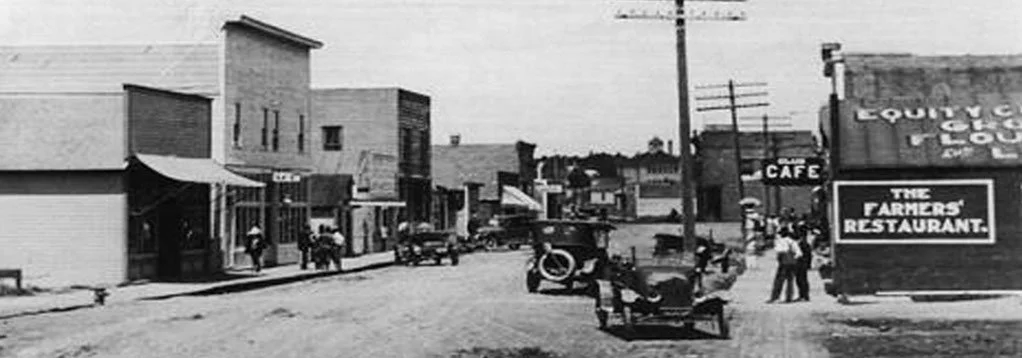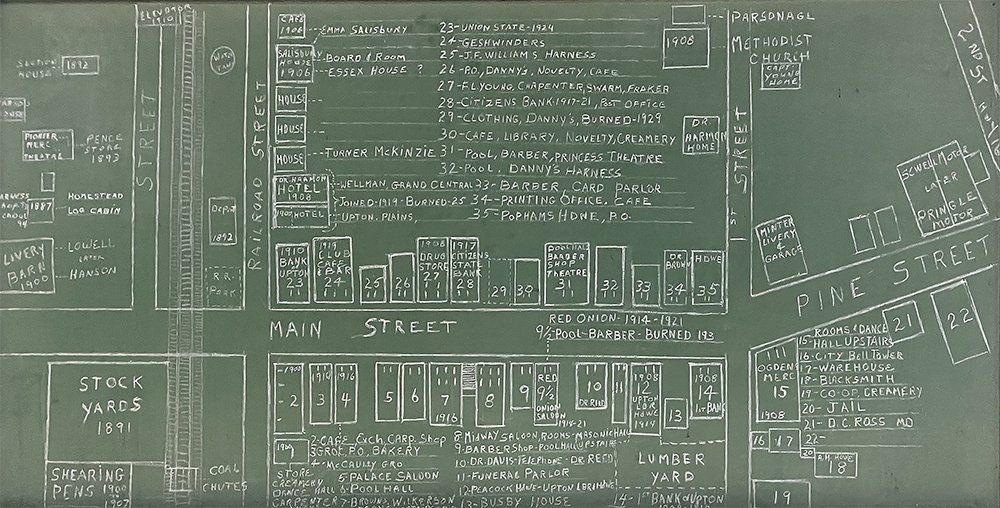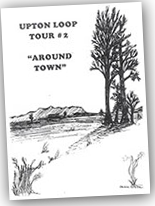DISCOVER UPTON
A devastating fire in 1926 at the newspaper offices in Upton turned to ash much of the record of the town’s early days. As a result, most of the town’s history has been drawn from the scant remaining records and the testimony of old timers from the area. According to the authoritative work, Weston County, Wyoming: The First 100 Years, compiled by the Weston County Heritage Group in 1988, the town of Upton can trace its roots to the mid-1880s.
Upton started as a railroad depot and grew into a small town. Before the founding of Upton, Iron Town sprung up west of Iron Creek in the late 1880s. “It sprang up beside the banks of Iron Creek and was then called Irontown,” the authors wrote. “There was no running water in the creek, only holes and reservoirs of standing water. It was said that the only good thing you could say about the water was that it was ‘wet.’ It was a brackish, metallic-tasting liquid.” The Chicago Burlington and Quincy Railroad laid 25 miles of new track from Newcastle, Wyo., in the summer of 1890.
Following the terrible winter storms of 1886 and 1887 that decimated the cattle industry in the area, many ranchers and homesteaders moved into the sheep business, where the Merino was the most popular breed. After a railroad line was extended to the area from Newcastle to serve the centralized sheep shearing pens, the town was renamed Merino in honor of the sheep. Although the sheep industry eventually began to decline, a new railroad depot and supply station opened in 1892, which saved the town from fading completely. The Burlington Railroad built a water pipeline to supply the needs of the citizens. Adding to the town’s challenges, Merino, Colo., caused some confusion in mail delivery. In 1901, Merino, Wyo., changed its name to Upton after A. Z. “George” Upton, a surveyor for the railroad. Today, Upton’s industries include ranching, oil, and bentonite mining.
The authors noted Upton probably began its corporate life as a supply stop for cowboys, ranchers, and homesteaders who were rapidly populating the area.
In his work “Only a Cow Country,” author Dick Nelson, who visited Irontown as a part of a surveying crew, made note of the lively night life that possessed the town even in those early days. “…The noise and laughter from the saloon girls and cowboys kept them awake all night,” Nelson was quoted. “About sunup the next morning, two of the cowboys from the night before were dragging one of the ‘girls’ to the edge of the city’s well. She was tossed in, dunked several times, and then pulled out.
“One of the tent restaurant’s employees stood patiently by, watching until the two were done helping the lady take her morning bath. When they were finished, the employee stooped down and dipped up a pail of water, took it back to the restaurant, and started the morning coffee brewing.”
The Burlington Railroad was a major driver of development in Upton in the next several years, and sheepmen in the area eventually benefited from connections it provided for their wool to markets in Omaha and Kansas City.
The town of Upton has changed dramatically over the years, with the ups and downs of industry, business, wartime, and peace. One of the most significant changes to the town came in the early 1930s when
Interior of Upton's Red Onion Saloon in 1914.
a road was constructed connecting it to Moorcroft, some 20 miles away along today’s Highway 16. Businesses began to spring up along this roadway, and today the stretch of highway within Upton marks the heart of the downtown area. In 2010, the U.S. Census recorded 1,100 residents in Upton, and the town attracts visitors to the community with its beautiful City Park, historic Old Town area, and even the Cedar Pines Golf Course. The Red Onion Museum in Upton offers history enthusiasts an opportunity to delve into more of the rich history of the town and surrounding areas.
Diagram of old Upton drawn by Don Gose.
Make the Loop
Explore Historic Upton, Wyoming
Old Town
Fans of Old West history will want to stop at “Old Town,” the site of the old Irontown settlement which has been rebuilt by the people of Upton in recent years.
Visitors can enjoy tours of the interactive site, which features historic cabins and buildings from the early days of the town. A sod house was constructed in 1997 using a Depression-era sod cutter with materials from Bill Barton’s ranch west of Upton.
Other structures relocated to the Old Town site include the Clingan cabin, Hawkins cabin, Rankin log house, Hawkins blacksmith shop, Upton’s old fire hall, the Plachy ice house, Osage’s “house of ill-repute,” and Watt’s water tank, barn, corral and blacksmith shop. In addition, several wagons have been restored and are on display in Old Town.
You can find more information about Old Town here, and a map to the site below.






